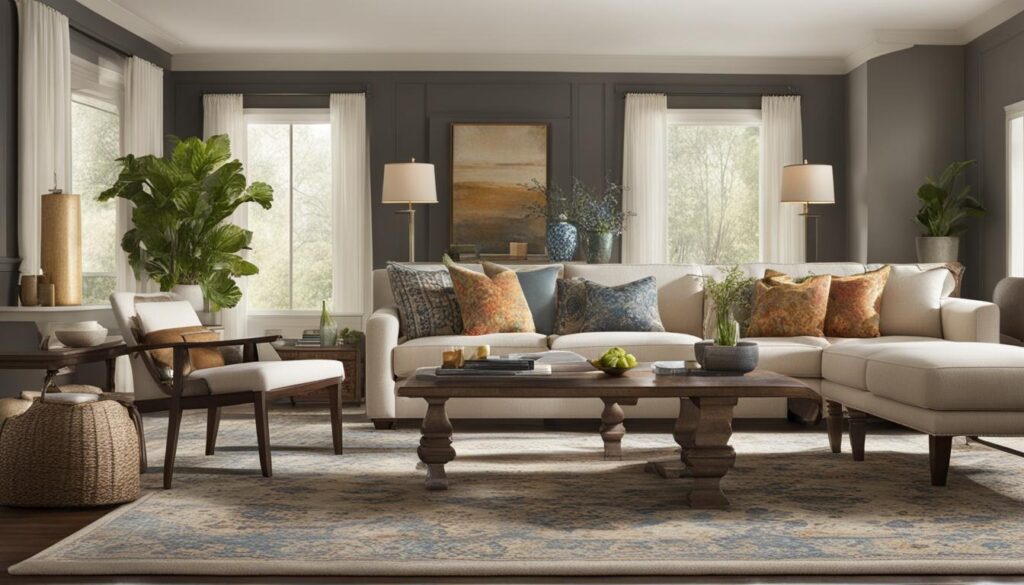When it comes to designing your living room, one element that can truly tie the space together is an area rug. Not only does it add warmth and texture to the room, but it can also define different areas within the space. However, placing an area rug in the living room requires careful consideration to ensure the right balance and harmony.

Here are some essential rug placement tips to help you create a stylish and functional living room:
Table of Contents
Key Takeaways:
- Make sure the area rug extends under all key pieces of furniture in the room.
- In a living room, all the furniture should be on top of the rug. If not possible, have the front legs of major upholstered pieces on the rug.
- Push the area rug against the wall at the head of the bed in the bedroom, leaving ample room for nightstands and clearance at the end of the bed.
- In a dining room, the rug should be large enough for the chairs as well as the table. The chairs should always be on the rug.
- Placing an area rug in high-traffic areas prevents unusual wear patterns on the rug and flooring.
Rug Placement Ideas for Different Room Sizes
When it comes to placing an area rug in your living room, it’s crucial to consider the size of your space and the furniture arrangement. The right rug can enhance the overall aesthetic of the room and create a visually appealing and cohesive look. Here are some rug placement ideas for different room sizes:
Smaller Living Rooms
In smaller living rooms, you have a few options for rug placement. You can use a smaller rug, such as a 5′ by 8′, as a focal point that floats in the room between the furniture. This allows the rug to unify the space without overpowering it. Alternatively, you can choose a larger rug that accommodates all the furniture to create a more cohesive look.
Mid-Sized Living Rooms
For mid-sized living rooms, an 8′ by 10′ rug is a great choice. Place anchor furniture, such as the sofa, with only the front legs on the rug. This creates a sense of unity and defines the seating area without overwhelming the space. Make sure there is enough room around the outside of the rug for walking.
Larger Living Rooms
In larger living rooms, opt for a bigger rug, such as a 9′ by 13′, to anchor the furniture. Place all the furniture completely on the rug to create a more cohesive and visually appealing look. Ensure there is still enough room around the outside of the rug for walking and to maintain a balanced aesthetic.
By considering the size of your room and following these rug placement ideas, you can create a stylish and well-proportioned living room that suits your needs and enhances the overall design.
| Room Size | Ideal Rug Size | Rug Placement |
|---|---|---|
| Smaller Living Rooms | 5′ by 8′ | Rug floats between furniture or accommodates all furniture |
| Mid-Sized Living Rooms | 8′ by 10′ | Anchor furniture with front legs on the rug |
| Larger Living Rooms | 9′ by 13′ | All furniture on the rug for a cohesive look |
Tips for Choosing the Right Rug for Your Space
When it comes to choosing a rug for your space, there are a few key factors to consider. The right rug can enhance your living room decor, define separate areas in an open floor plan, and anchor furniture in various rooms of your home. Let’s explore some tips to help you make the best choice for your space.
Living Room Decor with Rugs
If you want to elevate your living room decor with a rug, it’s essential to select one that complements your existing furniture and color scheme. Consider the style and tone of your living room and choose a rug that harmonizes with the overall aesthetic. A rug can tie the room together and add a polished touch to your space.
Rug Placement in Open Floor Plan
In an open floor plan, rugs can be used to define different areas or seating arrangements, creating distinct spaces within the larger room. Experiment with different rug sizes and shapes to delineate specific zones, such as a sitting area or dining nook. This not only adds structure to your space but also enhances the functionality and visual appeal of your home.
Rug Placement Under Furniture
Rug placement under furniture is not limited to the living room. You can also consider placing rugs under furniture in other areas of your home, such as the dining room or bedroom. By doing so, you can anchor the space and create a cohesive look. When selecting a rug for under furniture, ensure that it is large enough to accommodate the size and arrangement of the furniture, creating a balanced and visually appealing arrangement.
In summary, choosing the right rug for your space involves considering your overall decor, the layout of your home, and the size and placement of your furniture. By following these tips, you can select a rug that enhances your living room decor, defines separate areas in an open floor plan, and anchors furniture throughout your home. Remember to keep in mind the functionality, durability, and ease of cleaning of the rug material to ensure it’s a practical and stylish addition to your space.

| Rug Selection Considerations | Living Room Decor | Rug Placement in Open Floor Plan | Rug Placement Under Furniture |
|---|---|---|---|
| Complement existing furniture and color scheme | Define separate areas or seating arrangements | Anchor furniture in various rooms | |
| Consider style and tone of the living room | Create distinct spaces within a larger room | Enhance the overall aesthetic | |
| Choose a rug that harmonizes with the decor | Experiment with different rug sizes and shapes | Select a rug that accommodates furniture size and arrangement |
Conclusion
When it comes to rug placement in your living room, there are several key factors to consider in order to achieve the best result. By following these rug placement tips, you can create a visually appealing and harmonious space that enhances your overall living room decor.
The first step is to determine the best way to position a rug in your living room. Ensure that the rug extends under all the key furniture pieces, creating a cohesive and unified look. Leave equal space on all sides of the rug to achieve a balanced appearance in the room. Aim to have the rug centered to create a visually appealing focal point.
Choosing the right rug for your living room is also crucial. Consider the size of your living room and select a rug size that fits well within the space. Whether you have a smaller living room, a mid-sized room, or a larger living room, there are specific rug placement ideas to suit your needs. Remember to take into account the overall decor and color scheme of your living room, ensuring that the rug complements the existing furniture and style.
In conclusion, by following these rug placement tips and choosing the right rug for your living room, you can create an inviting and stylish space. Pay attention to the size, placement, and overall aesthetic of the room, and always consider the function and traffic patterns within the space. With careful consideration and attention to detail, you can achieve a beautifully arranged living room that showcases your personal style and enhances the overall ambiance of your home.
FAQ
How should I place an area rug in the living room?
When selecting an area rug for your living room, make sure it extends under all the key pieces of furniture in the room. All the furniture should be on top of the rug, or if that’s not possible, have the front legs of major upholstered pieces on the rug and the back legs off. Ensure that all the legs of smaller pieces are on the rug.
What should be the rug placement in the bedroom?
In the bedroom, push the area rug all the way against the wall at the head of the bed, leaving ample room for nightstands and clearance at the end of the bed. For a queen bed, a rug size of 8′ by 10′ is recommended, while a king bed would look better with a 9′ by 12′ rug. Consider placing the rug partially under the bed by laying it perpendicular to the bed and pulling it under, stopping a few inches before the nightstands.
How should I place a rug in the dining room?
In the dining room, the rug should be large enough for the chairs as well as the table. The chairs should be on the rug, even when they’re pulled out from the table. Center the rug under the dining table and ensure it’s large enough to accommodate all the chairs comfortably.
Why is placing an area rug in high-traffic areas important?
Placing an area rug in high-traffic areas is important to ensure that people don’t have one foot on the rug and one foot off, which can lead to unusual wear patterns on both the rug and the flooring. It helps maintain the integrity and appearance of both the rug and the floor.
How should I place a rug in an open floor plan?
When placing a rug in an open floor plan, use rugs to define different areas or seating arrangements. Use different rugs to demarcate distinct spaces within the larger room.
What should I consider when choosing a rug for my living room?
When choosing a rug for your living room, consider the size, placement, and overall aesthetic of the room. Be mindful of high-traffic areas, the function of the room, and the durability and ease of cleaning of the rug material. Also, consider how the rug complements the existing furniture and color scheme to create a cohesive look.
How should I place a rug under furniture?
When placing a rug under furniture, ensure that the rug is large enough to accommodate the furniture and provide a cohesive look. Consider the overall size and arrangement of the furniture when selecting the rug size. You can place rugs under furniture in other areas of your home, such as the dining room or bedroom, to anchor the space and create a visually appealing look.


